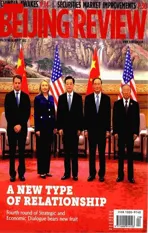Seeking Common Ground
2012-12-22本刊编辑部
Seeking Common Ground
The recently concluded fourth round of the China-U.S. Strategic and Economic Dialogue (S&ED) produced a wide range of positive outcomes.
Sixty-seven agreements were reached during the talks, jointly headed by Chinese Vice Premier Wang Qishan, State Councilor Dai Bingguo, and U.S. Secretary of State Hillary Clinton and Treasury Secretary Timothy Geithner, on issues such as trade, investment and fi nancial cooperation.
Trade relations have always been one of the main focuses of the talks.As a result of the dialogue, China has pledged to continue the reform of its exchange rate regime and improve the business environment for U.S.companies based in China. The United States will speed examination and approval procedures for Chinese financial institutions investing in the United States. It also agreed to relax restrictions on civilian technologies and hi-tech exports to China.
The two sides also sought common ground on other contentious issues.They af fi rmed their support for establishing the China-U.S. Maritime Safety Dialogue Mechanism and holding its fi rst dialogue this year. Another round of consultation on Asia-Paci fi c affairs and a human rights dialogue is scheduled later this year. They also exchanged views on the Korean Peninsula situation, Iran’s nuclear program, Syria and Sudan-South Sudan con fl icts.
More importantly, China and the United States agreed they must work together to forge a new type of power relationship centered on peaceful coexistence, benign competition and mutual bene fi t. This could be the most signi fi cant outcome yet achieved through the platform.
The new type of relationship will not be immune to differences or even con fl icts of interest between China and the United States, which have different political systems, cultural backgrounds and development levels.But these should not hinder cooperation nor should a single incident or individual affect the overall relationship. The incident involving Chen Guangcheng, a self-taught blind lawyer who entered the U.S. Embassy in Beijing in late April and later tried to seek education in the United States, is one such example.
The S&ED is one of the mechanisms that facilitate the cooperation between the world’s biggest developed nation and the world’s biggest developing nation. Since its establishment in 2009, the talks have contributed to business cooperation. In the meantime, it has worked to dispel distrust and sought common ground between the two nations. With joint efforts planned across the Paci fi c, the scope and in fl uence of the dialogue will continue to increase.
杂志排行
Beijing Review的其它文章
- MARKET WATCH
- Is Running Yellow Lights Illegal?
- Mass Producing Charity A venture capital investor uses his business savvy to maximize the impact of his philanthropic work
- The Art of Staying Relevant After thousands of years, Sun Tzu’s military treatise is still used and embraced by readers and leaders alike
- Making a Better Capital Market A series of new measures aim to ensure fairness, maintain sound development and protect investors’ interests
- Dealing With Loneliness Suicidal tragedies bring to light the plight of left-behind women in China By Wang Hairong
